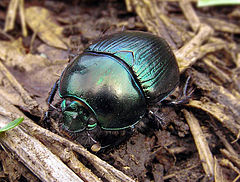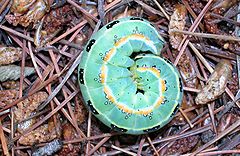- Arthropod cuticle
-
Beetles have hardened cuticle.
The cuticle forms the outer skeleton of arthropods, including insects.
Contents
Anatomy
The cuticle is made up of two layers; the epicuticle which is a thin and waxy water resistant outer layer and contains no chitin, and another layer under it called the procuticle. This is chitinous and much thicker than the epicuticle and has two layers, the outer being the exocuticle while the inner is the endocuticle. The tough and flexible endocuticle is built from numerous layers of fibrous chitin and proteins, criss-crossing each others in a sandwich pattern, while the exocuticle is rigid and sclerotized.[1] The exocuticle is greatly reduced in many soft-bodied insects, especially the larval stages (e.g., caterpillars).
Chemical composition
Chemically chitin is a long-chain polymer of a N-acetylglucosamine, a derivative of glucose. In its unmodified form, chitin is translucent, pliable, resilient and quite tough. In arthropods, however, it is often modified, becoming embedded in a hardened proteinaceous matrix, which forms much of the exoskeleton. In its pure form it is leathery, but when encrusted in calcium carbonate it becomes much harder.[2] The difference between the unmodified and modified forms can be seen by comparing the body wall of a caterpillar (unmodified) to a beetle (modified).
Moulting
From the embryonic stages itself, a layer of columnar or cuboidal epithelial cells give rise to the external cuticle and an internal basement membrane. The majority of insect material is held in the endocuticle. The cuticle provides muscular support and acts as a protective shield as the insect develops. However since it cannot grow the external sclerotised part of the cuticle is periodically shed in a process called "moulting". As the time for moulting approaches, most of the exocuticle material is reabsorbed. In moulting, first the old cuticle separates from the epidermis (apodysis). Enzymatic moulting fluid is released in between the old cuticle and epidermis which separates the exocuticle by digesting the endocuticle and sequestering its material for the new cuticle. When the new cuticle has formed sufficiently, the epicuticle and reduced exocuticle are shed in ecdysis.[3]:16-20
References
- ^ Gullan, P. J.; P. S. Cranston (2005). The Insects: An Outline of Entomology (3 ed.). Oxford: Blackwell Publishing. pp. 22–24. ISBN 1-4051-1113-5.
- ^ Campbell, N. A. (1996) Biology (4th edition) Benjamin Cummings, New Work. p.69 ISBN 0-8053-1957-3
- ^ Gene Kritsky. (2002). A Survey of Entomology. iUniverse. ISBN 9780595221431.
Categories:- Arthropod anatomy
Wikimedia Foundation. 2010.


